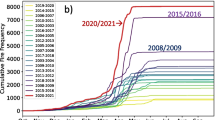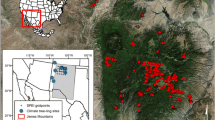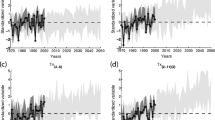Abstract
Trends of summer precipitation and summer temperature and their influence on trends in summer drought and area burned in British Columbia (BC) were investigated for the period 1920–2000. The complexity imposed by topography was taken into account by incorporating high spatial resolution climate and fire data. Considerable regional variation in trends and in climate–fire relationships was observed. A weak but significant increase in summer temperature was detected in northeastern and coastal BC, whereas summer precipitation increased significantly in all regions—by up to 45.9 %. A significant decrease in province-wide area burned and at the level of sub-units was strongly related to increasing precipitation, more so than to changing temperature or drought severity. A stronger dependence of area burned on precipitation, a variable difficult to predict, implies that projected changes in future area burned in this region may yield higher uncertainties than in regions where temperature is predominantly the limiting factor for fire activity. We argue that analyses of fire–climate relationships must be undertaken at a sufficiently high resolution such that spatial variability in limiting factors on area burned like precipitation, temperature, and drought is captured within units.






Similar content being viewed by others
References
BC Ministry of Forests and Range (2006a) Provincial biogeoclimatic subzone/variant mapping, version 6. Research Branch, Victoria
BC Ministry of Forests and Range (2006b) Provincial biogeoclimatic subzone/variant mapping with generalized land cover, version 6. Research Branch, Victoria
Bergeron Y, Flannigan M, Gauthier S, Leduc A, Lefort P (2004) Past, current and future fire frequency in the Canadian boreal forest: implications for sustainable forest management. Ambio 33:356–360
Christensen JH, Hewitson B, Busuioc A et al (2007) Regional climate projections. In: Solomon S, Qin D, Manning M et al. (eds) Climate change 2007: the physical science basis. Contribution of working group I to the fourth assessment report of the intergovernmental panel on climate change. Cambridge University Press, Cambridge, United Kingdom and New York, USA
Dai A, Trenberth KE, Qian T (2004) A global dataset of Palmer Drought Severity Index for 1870–2002: relationship with soil moisture and effects of surface warming. J Hydrometeorol 5:1117–1130
Daly C, Kittel TGF, McNab A et al (2000), Development of a 103-year high-resolution climate data set for the conterminous United States. In: Proceedings of 12th AMS conference on applied climatology, Asheville, NC, 8–11 May. American Meteorological Society, pp 249–252
Daly C, Gibson WP, Taylor GH, Johnson GL, Pasteris P (2002) A knowledge-based approach to the statistical mapping of climate. Clim Res 22:99–113
Dawdy DR, Matalas NC (1964) Statistical and probability analysis of hydrologic data. Part III: analysis of variance, covariance, and time series. In: Te Chow V (ed) Handbook of applied hydrology. A compendium of water resources technology. McGraw-Hill Book Company, New York, pp 68–90
Easterling DR, Karl TR, Gallo KP, Robinson DA, Trenberth KE, Dai AG (2000) Observed climate variability and change of relevance to the biosphere. J Geophys Res 105:20101–20114
Flannigan MD, Harrington JB (1988) A study of the relation of meteorological variables to monthly provincial area burned by wildfire in Canada (1953–80). J Appl Meteorol 27:441–452
Gavin DG, Hallett DJ, Hu FS, Lertzman KP, Prichard SJ, Brown KJ, Lynch JA, Bartlein PJ, Peterson DL (2007) Forest fire and climate change in western North America: insights from sediment charcoal records. Frontiers Ecol Environ 5:499–506
Girardin MP, Wotton BM (2009) Summer moisture and wildfire risks across Canada. J Appl Meteorol Climatol 48:517–533
Girardin MP, Flannigan MD, Tardif JC, Bergeron Y (2009) Climate, weather, and forest fire. In: Gauthier S, Vaillancourt MA, Leduc A, De Grandpré L, Kneeshaw D, Morin H, Drapeau P, Bergeron Y (eds) Ecosystem management in the boreal forest. Presses de l’Université du Québec, Québec, p 392
Guttman NB (1991) A sensitivity analysis of the Palmer Hydrologic Drought Index. Water Res Bull 27:797–807
Hamann A, Wang TL (2005) Models of climatic normals for genecology and climate change studies in British Columbia. Agric For Meteorol 128:211–221
Isaac GA, Stuart RA (1992) Temperature precipitation relationships for Canadian stations. J Clim 5:822–830
Jiang Y, Zhuang Q, Flannigan M, Little J (2009) Characterization of wildfire regimes in Canadian boreal terrestrial ecosystems. Int J Wild Fire 18:992–1002
Kendall MG (1970) Rank correlation methods. Griffin London Publishing, London
Lefort P, Gauthier S, Bergeron Y (2003) The influence of fire weather and land use on the fire activity of the Lake Abitibi area, eastern Canada. For Sci 49:509–521
Luckman BH, Wilson RJS (2005) Summer temperatures in the Canadian Rockies during the last millennium: a revised record. Clim Dyn 24:131–144
Mann HB (1945) Nonparametric tests against trend. Econometrica 13:245–259
Mbogga MS, Hamann A, Wang TL (2009) Historical and projected climate data for natural resource management in western Canada. Agric For Meteorol 149:881–890
Meidinger D, Pojar J (1991) Ecosystems of British Columbia, BC Ministry of Forests, Research Branch, Special Report Series 6, Victoria, BC, Canada
Meyn A, Schmidtlein S, Taylor SW, Girardin MP, Thonicke K (2010a) Spatial variation of trends in wildfire and summer drought in British Columbia, Canada, 1920–2000. Int J Wildland Fire 19:272–283
Meyn A, Taylor SW, Flannigan MD, Thonicke K, Cramer W (2010b) Relationship between fire, climate oscillations and drought in British Columbia, Canada, 1920–2000. Glob Change Biol 16:977–989
Mitchell TD, Jones PD (2005) An improved method of constructing a database of monthly climate observations and associated high-resolution grids. Int J Climatol 25:693–712
Mote PW (2003) Trends in temperature and precipitation in the Pacific Northwest during the twentieth century. Northwest Sci 77:271–282
Podur J, Martell DL, Knight K (2002) Statistical quality control analysis of forest fire activity in Canada. Can J For Res 32:195–205
Sen PK (1968) Estimates of the regression coefficient based on Kendall’s tau. J Am Stat Assoc 63:1379–1389
Stahl K, Moore RD, McKendry IG (2006) The role of synoptic-scale circulation in the linkage between large-scale ocean-atmosphere indices and winter surface climate in British Columbia, Canada. Int J Climatol 26:541–560
Taylor SW, Thandi G (2003) Development and analysis of a provincial natural disturbance database. Pacific Forestry Centre, Natural Resources Canada, Victoria
Taylor SW, Carroll AL, Alfaro RI, Safranyik L (2006) Forest, climate and mountain pine beetle outbreak dynamics in western Canada. In: Safranyik L, Wilson WR (eds) The mountain pine beetle: a synthesis of biology, management, and impacts in lodgepole pine. Natural Resources Canada, pp 67–94
Theil H (1950) A rank-invariant method of linear and polynomial regression analysis. Indag Math 12:85–91
Thornthwaite CW (1948) An approach toward a rational classification of climate. Geogr Rev 38:55–94
Trenberth KE, Shea DJ (2005) Relationships between precipitation and surface temperature. Geophys Res Lett 32:L14703
Trenberth KE, Jones PD, Ambenje P et al (2007) Observations: surface and atmospheric climate change. In: Solomon S, Qin D, Manning M et al. (eds) Climate change 2007: the physical science basis. Contribution of working group I to the fourth assessment report of the intergovernmental panel on climate change. Cambridge University Press, Cambridge, United Kingdom and New York, NY, USA
United Nations Environment Programme (UNEP) (1992) World atlas of desertification. Edward Arnold, London
Vincent LA, Mekis E (2009) Discontinuities due to joining precipitation station observations in Canada. J Appl Meteorol Climatol 48:156–166
Vincent LA, van Wijngaarden WA, Hopkinson R (2007) Surface temperature and humidity trends in Canada for 1953–2005. J Clim 20:5100–5113
Wang T, Hamann A, Spittlehouse DL, Aitken SN (2006) Development of scale-free climate data for western Canada for use in resource management. Int J Climatol 26:383–397
Watson E, Luckman BH (2004) Tree-ring based reconstructions of precipitation for the southern Canadian Cordillera. Clim Change 65:209–241
Wells N, Goddard S, Hayes MJ (2004) A self-calibrating palmer drought severity index. J Clim 17:2335–2351
Wotton BM (2008) Interpreting and using outputs from the Canadian forest fire danger rating system in research applications. Environ Ecol Stat 16:107–131
Zhang XB, Vincent LA, Hogg WD, Niitsoo A (2000) Temperature and precipitation trends in Canada during the 20th century. Atmos Ocean 38:395–429
Acknowledgments
A.M. thanks the German Academic Exchange Service (DAAD) and the Stiftung der deutschen Wirtschaft (sdw) for grants. We thank Lucie A. Vincent for helpful comments on the manuscript, and Monique Kieran and Shelly Church for reviewing the manuscript.
Author information
Authors and Affiliations
Corresponding author
Rights and permissions
About this article
Cite this article
Meyn, A., Schmidtlein, S., Taylor, S.W. et al. Precipitation-driven decrease in wildfires in British Columbia. Reg Environ Change 13, 165–177 (2013). https://doi.org/10.1007/s10113-012-0319-0
Received:
Accepted:
Published:
Issue Date:
DOI: https://doi.org/10.1007/s10113-012-0319-0




